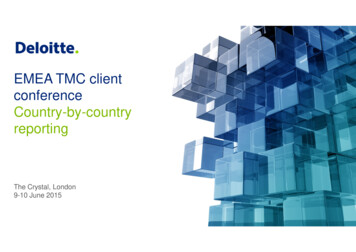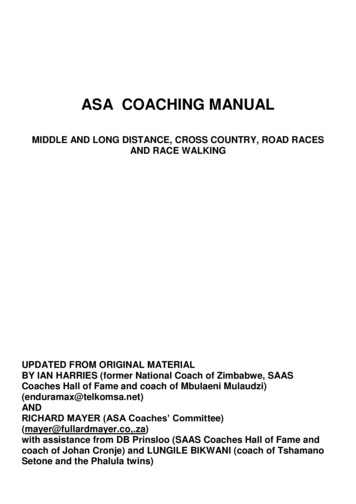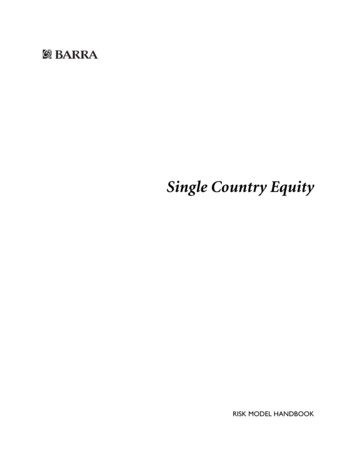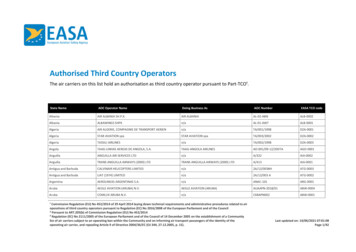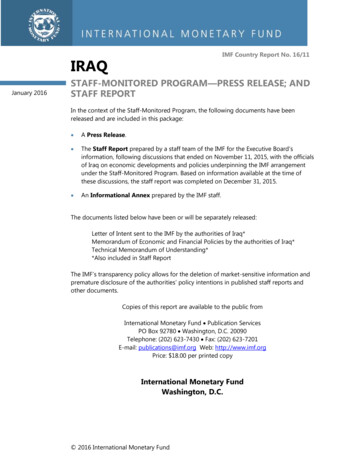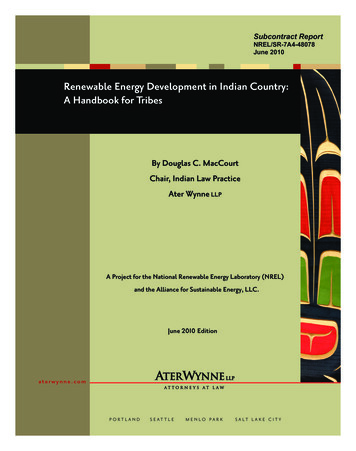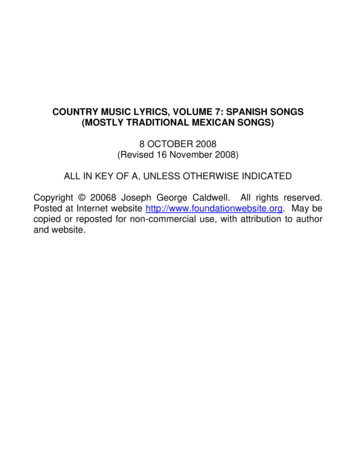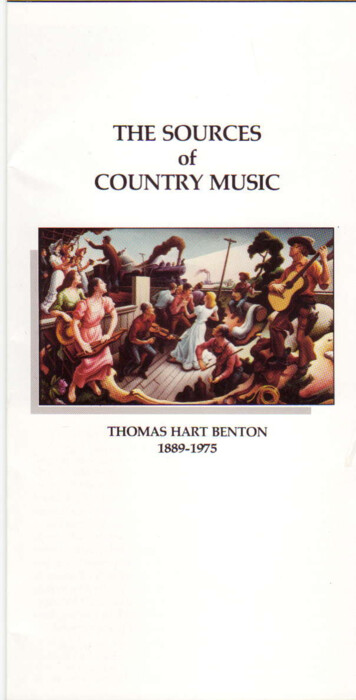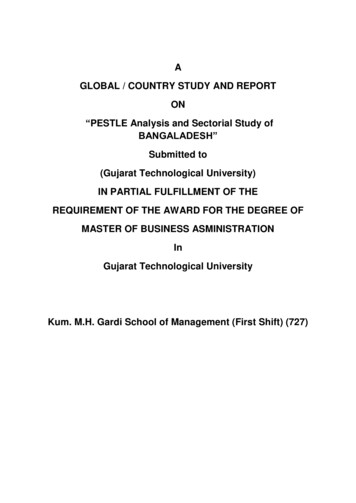
Transcription
AGLOBAL / COUNTRY STUDY AND REPORTON“PESTLE Analysis and Sectorial Study ofBANGALADESH”Submitted to(Gujarat Technological University)IN PARTIAL FULFILLMENT OF THEREQUIREMENT OF THE AWARD FOR THE DEGREE OFMASTER OF BUSINESS ASMINISTRATIONInGujarat Technological UniversityKum. M.H. Gardi School of Management (First Shift) (727)
PREFACEToday we are at the door step of 21st century. The world is widening without havinga New and new developments are coming these days in all fields all over India tomake the people life more comfortable and luxurious. The industries are growing sofast in India in order to satisfy all the needs of people. Similarly Gov. has supportedto these companies for their development and progress of private companies.Practical Study plays a vital role in the field of education. It has been introduced forthe students to get practical knowledge along with the theoretical knowledge; onlybookish knowledge is not the right way of learning anything especially for themanagement students. How management principles are implemented in businesscan only be known through practical study through visit, students can be berry wellbecome ware about industrial environment like problem, opportunities, differentsituations etc. This helps the students for better understanding & gives then achance to show their skills & ability.According to the above reviews our Gujarat Technological University has includedGlobal Country Report & viva of it, With a view to expand our boundaries of thinkingabout implications of the theoretical knowledge in practical field, We have preferred―Bangladesh‖. We are supposed to work on ―Pestle Analysis and Sector Analysis ofBangladesh‖ It is a matter of great pleasure to present this report work.Thus in order to survive in the market one should have theoretical as well asPractical knowledge about all different fields prevailing in market.
Executive SummaryAs Bangladesh followed a socialist economy by nationalizing all industries after itsIndependence, it undergoes a slow growth of producing knowledgeableentrepreneurs, engineers, managers, administrators & technicians.Growth of Bangladesh in agro industries is because of its rich deltaic fertile land thatdepends on its manifold harvests & six seasons also on. The country's industrialbase remains very positive. The service sector has developed rapidly during lasttwenty years.The legislative & regulatory actions to deal with financial irregularities & poorgovernance of the financial sector are developing over time to gather the increasingprotection needs of the consumers. The following measures may be considered aspart of on-going efforts to expand financial infrastructure & improve the security &soundless of the financial sector.Economists said that it will be wise on the part of the government to expand theexisting social safety net. Economists said a controlling system can be launched inthe rural areas to overcome the crisis.The New Deal programmed for workers aged Twenty five plus has been running fora short of time period. Nonetheless less than 15% of participants have moved intoemployment. In some areas only one human being in ten has accepted through theprogrammed into either a subsidized job or non-subsidized employment.In the first part of GCR we have included the PESTLE Analysis of BangladeshCountry to know the overall development of Bangladesh.In the second part of GCR we have included the study of various sector inBangladesh like Textile & Garment, FMCG, Banking, Insurance, Food, Cement andFinancial Institutions and had also compared with Indian Economic states. We foundthat they are little bit underdeveloped country then India.
IndexSr.No.ParticularsPrefaceExecutive SummaryPart – 1PESTLE Analysis of Bangladesh1.1Political Analysis1.2Economical Analysis1.3Social Analysis1.4Technological Analysis1.5Legal Analysis1.6Environmental Analysis1.7Economical AnalysisPart – 2Sectorial Study of Bangladesh1.1Textile & Garment Sector1.2FMCG Sector1.3Banking Sector1.4Food Sector1.5Cement Sector1.6Insurance Sector1.7Financial Institution SectorPageNo.
Part 1PESTLE AnalysisPolitical Analysis Bangladesh:Bangladesh is rapidly changing as a dominant two-party system; BNP (Center-Right)and Awami League (Center-Left), to a very belief specific Liberation Movement. Inshort, Bangladesh has a parliamentary democracy.TAXATION POLICYIn Bangladesh, the Principal Direct Taxes are personal Income Taxes and CorporateIncome taxes, and a value-added tax of 15% levied on all important consumergoods. The Tax Rate for characters is 25%. For the 2011-12 tax year starting from 1July, 2011 & ends on 30 June, 20112 the upper corporate rate was 45%. However,publicly traded companies registered in Bangladesh are charged a lower rate of27.5%. Banks, Financial Institutions and Insurance Companies are charged the 45%rate. All other companies are taxed at the 37.5% rate.PARTIES IN BANGLADESHØ Bangladesh Awami League,Ø The Bangladesh Nationalist Party (BNP) &Ø The Bangladesh Jamaat-e-Islami (BJI).GOVERNMENTThe legislature includes 300-seat body. All of its members are chosen by worldwidesuffrage in least every 5 years. Parliament amend the organization in the month ofMay 2004, provision for 45 seats was made & kept for women which is to bedistributed among political parties in proportion to their numerical strength ingoverning body. With a view to fill the reserved seats for women, many women'sgroups have demanded direct election.Democracy and Human Rights: The parliamentary process and the political dialogueat the national level are presently not conducive to broad socioeconomicdevelopment. The democracy is young and fragile and state institutions are weak. Atthe national level political bickering is driven by personal and power rivalry betweenthe government and the opposition.The incidence of violence, even murdering of political figures and journalists, seemsto have increased during recent years. The law and order situation is not upheld insociety and the risk for further deterioration is apparent. Human rights violationscontinue, especially linked with political activities. At the local level there has beensome positive progress, but the democratic process is shaky and dependent on thelocal power structure. Consequently, the majority of the population is unable to havea voice in the political process and lacks access to decision-making, both locally and
nationally. Therefore, there is challenge for the country to create a real participatorydemocracy, built on the rule of law for all its citizens.Democratic Good Governance: The centralized, corrupt and inefficient statestructure is a hindrance to development. There is limited accountability andtransparency, which has created a breeding ground for corruption and a growingmistrust from the public. The public administration also lacks financial and adequatehuman resources to perform its duties.The plans for a comprehensive public administration reform have been delayed duetopolitical procrastination and bureaucratic inertia. As the corrupt and inefficient statestructure is one of the main obstacles for development, there is a need for thegovernment and donors to put attention on this issue. Currently, several donors, e.g.UNDP, the World Bank and Asian Development Bank, have projects within this area,albeit with few results, as the right political climate appears to be lacking.The issue of good governance and corruption prevention will, however, be the maintopic on the development agenda in Bangladesh for the next five to ten years. As thepolitical situation currently faces difficulties and even civil unrest, Bangladesh seemsto have lost its impetus for needed structural reforms.Decentralization through local government reform is another area where there is aneed for continued progress. In reality, very little decentralization has taken place.The link between the community and its elected representatives at Union andPourashavas level has received little attention.As Bangladesh has in place a democratic system at the local level, there is scope forstrengthening one of the basic human rights: the right to participate actively anddirectly in local political decision-making processes. But the elected local bodies areweak and lack human and financial capacity. There is also a need for capacitybuilding of the local administration in terms of accountability and transparency.These are areas where donors most likely will draw their attention to during thecoming years.
Economical Analysis Bangladesh:South Asian economies are intending to carry out trade facilitation measures that willgreatly reduce present physical & nonphysical barriers to transportation & transit—bythe way of both visible infrastructure (such as multimodal corridors and terminals)and invisible infrastructure (such as reformed policies, procedures, and regulations).Due to lack of adequate research on trade facilitation in South Asia, not muchinformation is available on the existing profile of trade facilitation measures (both atthe border and the capital) in South Asia. This is a research area that needs specialattention from policymakers & researchers in South Asia.With an increased emphasis on administrative reform, governance & security, thecall for an efficient & effective customs administration is felt urgently. Customs is anintrinsic element of any cross-border movement of goods and services & yieldsimportant influence on the national economy.It is the unique point where the supply chain & routine access to trade intelligenceand data meet. Beyond facilitating trade, customs performs other significantfunctions such as income collection & protection against dangerous goods. The timetaken for clearance of goods has an force on the competitiveness of countries in theglobal context.One of the main reasons for the high transaction costs of India‘s exports toBangladesh is unwieldy & composite cross-border trading procedures. Complexrequirements in cross border trade increase the possibility of corruption. Forinstance, at the key border-crossing point between India & Bangladesh, as many as1,500 trucks queue on both the sides of the border with waiting times varyingbetween 1 & 5 days to complete documentation requirements. Expediting customsclearance procedures reduces the optional power of customs officials, thus reducingthe scope for corruption. An efficient, friendly, and corruption-free customs can helpboost trade & investment. The goods carried by road from India are subjected totranshipment at the border. Similarly, goods carried by rail are subjected to inlandtranshipment.As far as marine transport is concerned, there are no direct sailings. Thetranshipments at the land customs stations impose serious impediments. In fact,they determine the level & the efficiency of international trade between the twocountries. The position is further compounded by lack of harmonization of technicalstandards for rolling stock & infrastructure, both road & rail.Considering this region‘s appearance as a free trade area from 2006 onward, reformin the transport sector will aid South Asian countries assess likely benefits of movingto a deregularized transport sector under a liberal trading regime when the transportsector is one of the prime instruments for promoting intra-regional trade.Hence, countries in this region should take immediate steps in not only integratingtheir transport system but also in reforming the entire system so that the transportsystem functions as the engine of growth rather than as a trade deterrent. The
Government of Bangladesh should try to remove the structural asymmetries in therail & marine transportation sector that are found to be quite important.History:The economy has grown at the rate of 6 to7% per annum over the past few years.More than half of the Gross domestic Product is generated by the service sector,while nearly half of Bangladeshis are employed in the agriculture sector. Othergoods produced are jute, fish, fruit, vegetables, leather goods, textiles, ceramics, andready made goods.Bangladesh has made substantial stride in its economic sectorperformance since independence in 1971. Even though the economy has improvedgreatly in the 1990s, Bangladesh still suffers in the area of foreign trade in SouthAsian region.Current Scenarios:Despite major impediments to growth like the inefficiency of state-owned enterprises,a rapidly growing labour force that can‘t be absorbed by agriculture, inadequatepower supplies & sluggish implementation of economic reforms. The World Bank ishelping Bangladesh address its main boost areas through a mix of analytic work,technical assistance & lending. Analytic work has paying attention on investmentclimate issues, export competitiveness, the post Multi-Fibber Agreement (MFA)situation & strategy for long-term increase & employment concern. On the lendingside, a series of growth support credits, (DSC I, DSC II & DSC III) have supportedstructural improvements in infrastructure, monetary sector, trade, governance & taxadministration.The Bank‘s other lending functions involves an Enterprise Increase & BankModernization Project, Rural Transport Improvement Project & a series of EducationSector Adjustment Credits (SAC I and SAC II).Economic Growth of Bangladesh:The Gross Domestic Product (GDP) in Bangladesh was worth 110.61 billion USdollars in 2011, according to a report issued by the World Bank. The Gross DomesticProduct value of Bangladesh is approximately equivalent to 0.18 percent of the worldeconomy. Historically, from 1960 until 2011, Bangladesh GDP averaged 30.3 BillionUS dollar reaching an all time high of 110.6 Billion US dollar in December of 2011 &a record low of 4.3 Billion US dollar in December of 1960. The Gross DomesticProduct (GDP) measures of national income & yield for a given country's economy.The gross domestic product (GDP) is equal to the total expenditures for all finalgoods & services produce
PESTLE Analysis Political Analysis Bangladesh: Bangladesh is rapidly changing as a dominant two-party system; BNP (Center-Right) and Awami League (Center-Left), to a very belief specific Liberation Movement. In short, Bangladesh has a parliamentary democracy. TAXATION POLICY In Bangladesh, the Principal Direct Taxes are personal Income Taxes and Corporate Income taxes, and a value-added

